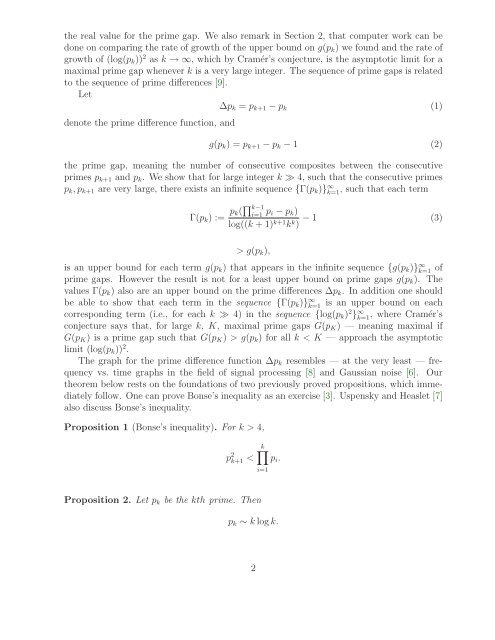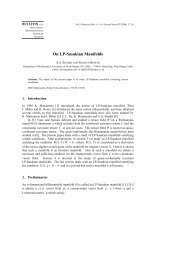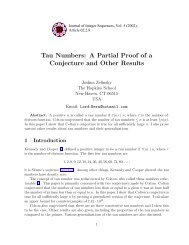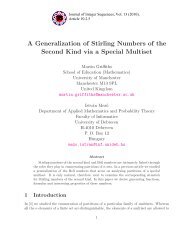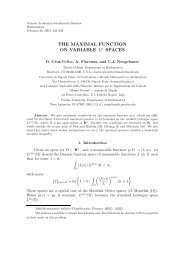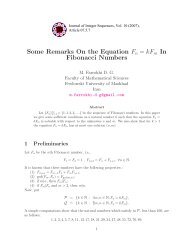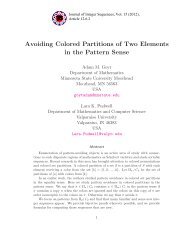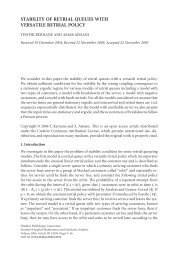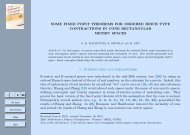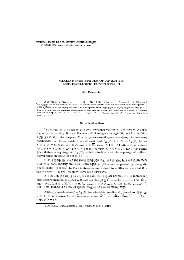Using Bonse's Inequality to Find Upper Bounds on Prime Gaps
Using Bonse's Inequality to Find Upper Bounds on Prime Gaps
Using Bonse's Inequality to Find Upper Bounds on Prime Gaps
You also want an ePaper? Increase the reach of your titles
YUMPU automatically turns print PDFs into web optimized ePapers that Google loves.
the real value for the prime gap. We also remark in Secti<strong>on</strong> 2, that computer work can bed<strong>on</strong>e <strong>on</strong> comparing the rate of growth of the upper bound <strong>on</strong> g(p k ) we found and the rate ofgrowth of (log(p k )) 2 as k → ∞, which by Cramér’s c<strong>on</strong>jecture, is the asymp<str<strong>on</strong>g>to</str<strong>on</strong>g>tic limit for amaximal prime gap whenever k is a very large integer. The sequence of prime gaps is related<str<strong>on</strong>g>to</str<strong>on</strong>g> the sequence of prime differences [9].Let∆p k = p k+1 − p k (1)denote the prime difference functi<strong>on</strong>, andg(p k ) = p k+1 − p k − 1 (2)the prime gap, meaning the number of c<strong>on</strong>secutive composites between the c<strong>on</strong>secutiveprimes p k+1 and p k . We show that for large integer k ≫ 4, such that the c<strong>on</strong>secutive primesp k ,p k+1 are very large, there exists an infinite sequence {Γ(p k )} ∞ k=1 , such that each termΓ(p k ) := p k( ∏ k−1i=1 p i − p k )log((k + 1) k+1 k k ) − 1 (3)> g(p k ),is an upper bound for each term g(p k ) that appears in the infinite sequence {g(p k )} ∞ k=1 ofprime gaps. However the result is not for a least upper bound <strong>on</strong> prime gaps g(p k ). Thevalues Γ(p k ) also are an upper bound <strong>on</strong> the prime differences ∆p k . In additi<strong>on</strong> <strong>on</strong>e shouldbe able <str<strong>on</strong>g>to</str<strong>on</strong>g> show that each term in the sequence {Γ(p k )} ∞ k=1 is an upper bound <strong>on</strong> eachcorresp<strong>on</strong>ding term (i.e., for each k ≫ 4) in the sequence {log(p k ) 2 } ∞ k=1 , where Cramér’sc<strong>on</strong>jecture says that, for large k, K, maximal prime gaps G(p K ) — meaning maximal ifG(p K ) is a prime gap such that G(p K ) > g(p k ) for all k < K — approach the asymp<str<strong>on</strong>g>to</str<strong>on</strong>g>ticlimit (log(p k )) 2 .The graph for the prime difference functi<strong>on</strong> ∆p k resembles — at the very least — frequencyvs. time graphs in the field of signal processing [8] and Gaussian noise [6]. Ourtheorem below rests <strong>on</strong> the foundati<strong>on</strong>s of two previously proved propositi<strong>on</strong>s, which immediatelyfollow. One can prove B<strong>on</strong>se’s inequality as an exercise [3]. Uspensky and Heaslet [7]also discuss B<strong>on</strong>se’s inequality.Propositi<strong>on</strong> 1 (B<strong>on</strong>se’s inequality). For k > 4,p 2 k+1


